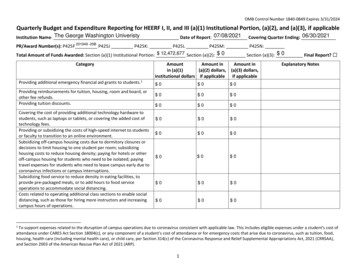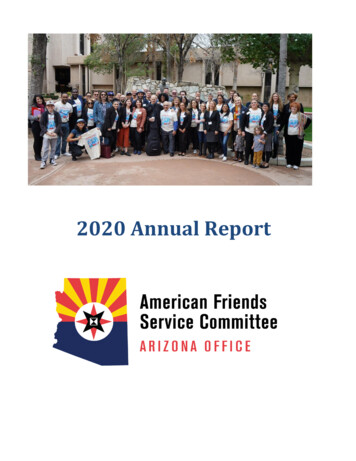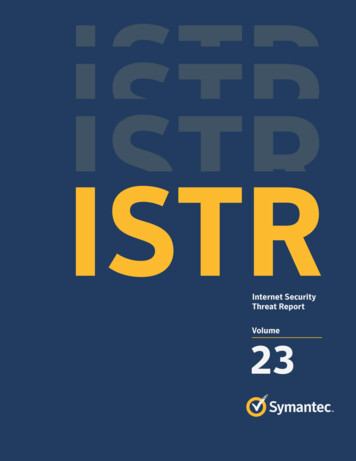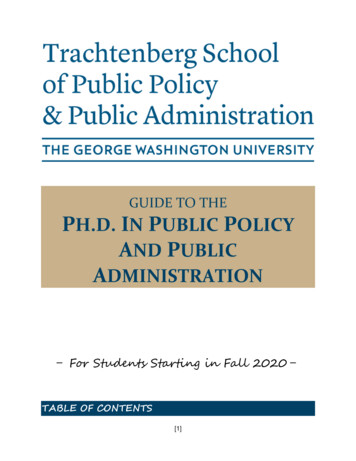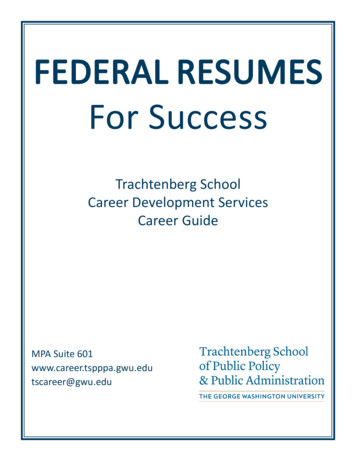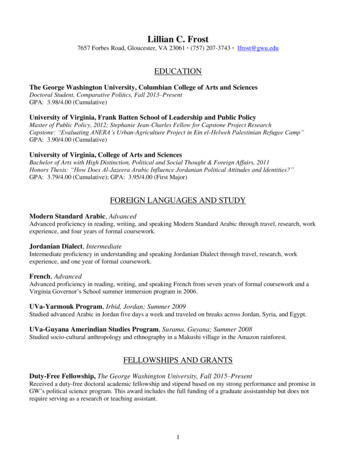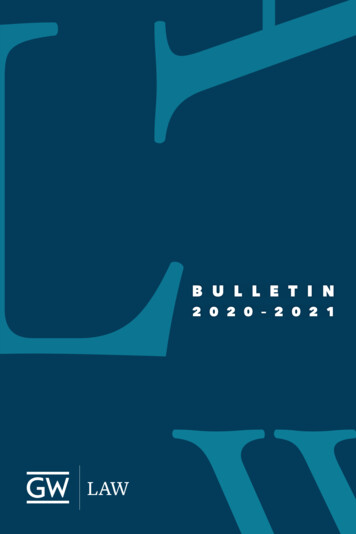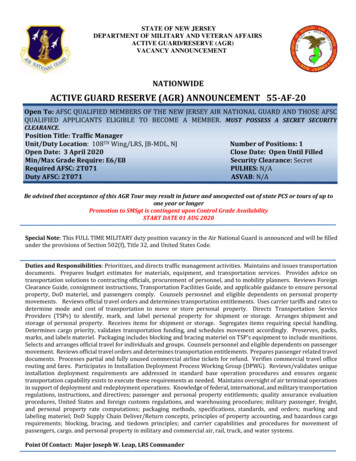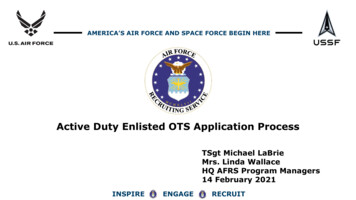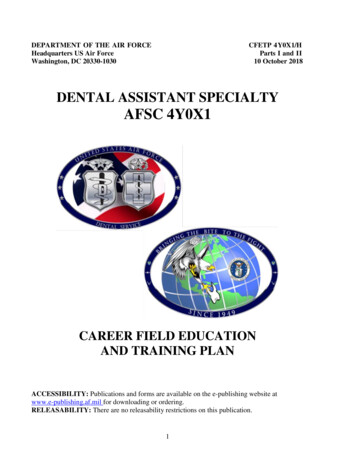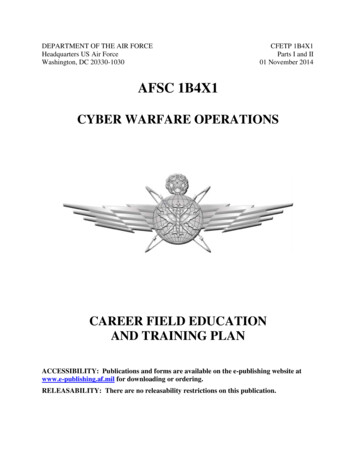
Transcription
DEPARTMENT OF THE AIR FORCEHeadquarters US Air ForceWashington, DC 20330-1030CFETP 1B4X1Parts I and II01 November 2014AFSC 1B4X1CYBER WARFARE OPERATIONSCAREER FIELD EDUCATIONAND TRAINING PLANACCESSIBILITY: Publications and forms are available on the e-publishing website atwww.e-publishing.af.mil for downloading or ordering.RELEASABILITY: There are no releasability restrictions on this publication.
CAREER FIELD EDUCATION AND TRAINING PLANCYBER WARFARE OPERATIONSAFSC 1B4X1TABLE OF CONTENTSPART IPreface.4Abbreviations/Terms Explained .5Section A - General Information.11Purpose of the CFETPUse of the CFETPCoordination and Approval of the CFETPSection B - Career Field Progression and Information .13Specialty DescriptionSkill/Career ProgressionCyber Warfare Operations Apprentice (1B431)Cyber Warfare Operations Journeyman (1B451)Cyber Warfare Operations Craftsman (1B471)Cyber Warfare Operations Superintendent (1B491)1B4X1 Career Path ChartTraining DecisionsCommunity College of the Air Force Academic ProgramsCareer Field Path1B4X1 Cyber Warfare Operations Career Path TableSection C - Skill Level Training Requirements .19PurposeSpecialty Qualification RequirementsApprentice (3-Level) TrainingJourneyman (5-Level) TrainingCraftsman (7-Level) TrainingSuperintendent (9-Level) TrainingSection D - Resource Constraints .22PurposeApprentice (3-Level) TrainingJourneyman (5-Level) TrainingCraftsman (7-Level) TrainingSuperintendent (9-Level) TrainingSection E - Transition Training Guide .222
Part IISection A - Specialty Training Standard .23Section B - Course Objective List .49Section C - Support Materials .49Air Force Job Qualification Standards and Air Force Qualification Training PackagesSection D - Training Course Index .49PurposeAir Force In-Residence CoursesAir University CoursesExportable CoursesSection E - MAJCOM-Unique Requirements .50OPR: 333 TRS/TRRApproved By: CMSgt John H. Sanders AFCFM (SAF/CIO A6SF)Supersedes: CFETP 1B4X1, dated 01 March 2013 W/Chg 1 dated 01 August 2014Pages: 503
CAREER FIELD EDUCATION AND TRAINING PLANCYBER WARFARE OPERATIONSAFSC 1B4X1PART IPreface1. This Career Field Education and Training Plan (CFETP) is a comprehensive education andtraining document that identifies life-cycle education/training requirements, training supportresources and minimum core task requirements for this specialty. The CFETP will providepersonnel a clear career path to success and instill rigor in all aspects of career field training.2. The CFETP documents the career field training program and consists of two parts.Management uses both parts in conjunction with Training Business Area (TBA) to plan, manageand control training within the career field. NOTE: Civilians occupying associated positionswill use Part II to support duty position qualification training.2.1. Part I provides information necessary for overall management of the specialty. Section Aexplains how everyone will use the plan; Section B identifies career field progressioninformation, duties and responsibilities, training strategies and career field path; Section Cassociates each level with specialty qualifications (knowledge, education, experience, trainingand other); Section D indicates resource constraints (e.g., funds, manpower, equipment,facilities); and Section E identifies transition training guide requirements for SSgt through MSgt.2.2. Part II includes the following: Section A identifies the Specialty Training Standard (STS)and includes duties, tasks, Training References (TRs) to support training, AETC-conductedtraining, wartime course and core task and correspondence course requirements. Section Bcontains the Course Objectives List (COL) and training standards supervisors will use todetermine if Airmen satisfied training requirements. Section C identifies available supportmaterials (e.g., Qualification Training Package, which may be developed to support proficiencytraining). Section D identifies a training course index supervisors can use to determine resourcesavailable to support training. Included here are both mandatory and optional courses; andSection E identifies MAJCOM-unique training requirements supervisors can use to determineadditional training required for the associated qualification needs. At unit level, supervisors andtrainers will use Part II to identify, plan and conduct training commensurate with the overallgoals of this plan.3. Use of the guidance provided in this CFETP provides the foundation for effective andefficient training for individuals in this career field at the appropriate points in their careers. Thisplan enables the Air Force to train today's work force for tomorrow's jobs.4
Abbreviations/Terms ExplainedThis section provides a common understanding of the terms that apply to the Cyber WarfareOperations CFETP.Advanced Training (AT). A formal course of training that leads to a technical or supervisorylevel of an Air Force Specialty (AFS). Training is for selected Airmen at the advanced level ofan AFS.Air and Space Expeditionary Force (AEF). The AEF is the Air Force’s methodology fororganizing, training, equipping, and sustaining rapidly responsive air and space forces to meetdefense strategy requirements. Through the AEF, consisting of enabler and tempo bandedcapabilities the Air Force supports defense strategy requirements using a combination of bothpermanently assigned and rotational (allocated) forces.Air Education Training Command (AETC). Responsible for the recruiting, training andeducation of Air Force personnel. AETC also provides pre-commissioning, professional militaryand continuing education.Air Force Career Field Manager (AFCFM). Representative appointed by the respective HQUSAF Deputy Chief of Staff or Under Secretariat to ensure that assigned Air Force specialtiesare trained and utilized to support Air Force mission requirements.Air Force Enlisted Classification Directory (AFECD). The official directory for all militaryenlisted classification descriptions, codes, and identifiers. Establishes the occupational structureof the Air Force enlisted force. The occupational structure is flexible to permit enlistedpersonnel to specialize and develop their skills and abilities while allowing the Air Force to meetchanging mission requirements. Individual enlisted personnel have a joint responsibility withcommanders and supervisors at all levels to fully develop their abilities consistent with Air Forceneeds and within the established patterns of specialization.Air Force Job Qualification Standard (AFJQS). A comprehensive task list that describes aparticular job type or duty position. Supervisors use the AFJQS to document task qualification.The tasks on AFJQSs are common to all persons serving in the described duty position.Air Force Qualification Training Package (AFQTP). An instructional course designed foruse at the unit to qualify or aid qualification in a duty position, program, or on a piece ofequipment. It may be printed, computer-based, or other audiovisual media.Air Force Specialty (AFS). A group of positions (with the same title and code) that requirecommon qualifications.Air Force Tactics, Techniques and Procedures (AFTTP). AFTTPs describe the properemployment of specific Air Force assets, individually or in concert with other assets, toaccomplish detailed objectives.Air University Associate-to-Baccalaureate Cooperative (AU ABC). Allows Airmen to turn aCommunity College of the Air Force Associates Degree into a Bachelor’s Degree from anaccredited university. The ABC program has established a partnership with various civilianhigher-education institutions to offer four-year degree opportunities via distance learning. Theparticipating schools will accept all of the credits earned by Airmen who have attained a CCAFdegree and apply them to a Bachelor’s degree related to their Air Force specialty.Air University/AFCDA (Air Force Career Development Academy). The result of areorganization of Air Force Institute for Advanced Distributed Learning (AFIADL); providesaccess to the Extension Course Institute.5
Career Field Education and Training Plan (CFETP). A CFETP is a comprehensive coretraining document that identifies: life-cycle education and training requirements; training supportresources; and minimum core task requirements for a specialty. The CFETP aims to givepersonnel a clear path and instill a sense of industry in career field training. CFETPs areofficially posted at http://www.e-publishing.af.mil/.Certification. A formal indication of an individual’s ability to perform a task to requiredstandards.Chief Enlisted Manager (CEM). Chief Master Sergeants that have extensive experience andtraining, and demonstrated managerial ability to plan, direct, coordinate, implement, and controla wide range of work activity. Some managerial duties and responsibilities that are common toall chief enlisted managers are: managing and directing personnel resource activities; interpretingand enforcing policy and applicable directives; establishing control procedures to meet workgoals and standards; recommending or initiating actions to improve functional operationefficiency; planning and programming work commitments and schedules; developing plansregarding facilities, supplies, and equipment procurement and maintenance.Command Line Interface (CLI). A command-line interface (CLI) is a means of interactionwith a computer program where the user (or client) issues commands to the program in the formof successive lines of text (command lines).Computer Based Training (CBT). A forum for training in which the student learns via acomputer terminal. It is an especially effective training tool that allows the students to practiceapplications while they learn.Continuation Training. Additional advanced training that exceeds the minimum upgradetraining requirements and emphasizes present or future duty assignments.Core Task. A task AFCFMs identify as a minimum qualification requirement for everyonewithin an AFSC regardless of duty position. Core tasks may be specified for a particular skilllevel or in general across the AFSC. Guidance for using core tasks can be found in the applicableCFETP narrative.Course Objective List (COL). A publication derived from initial/advanced skills CourseTraining Standard (CTS), identifying the tasks and knowledge requirements and respectivestandards provided to achieve a 3-skill level in this career field. Supervisors use the COL toassist in conducting graduate evaluations in accordance with AFI 36-2201, Air Force TrainingProgram.Course Training Standard (CTS). A standard developed for all courses not governed by anSTS, including specialized training packages and computer-based training courses.Critical Tasks. Critical Tasks are tasks that require specific training and certification above andbeyond other tasks. Tasks may be defined as critical either through AFI, Technical Orders,higher headquarters, or at any level in the unit.Cross-Utilization Training. Training on non-duty AFSC specific tasks.Defensive Cyberspace Operations (DCO). Passive and active cyberspace operations intendedto preserve the ability to utilize friendly cyberspace capabilities and protect data, networks, netcentric capabilities, and other designated systems (JP 1-02).Direct Reporting Unit (DRU). Air Force subdivisions directly subordinate to the CSAF. ADRU performs a mission that does not fit into any of the MAJCOMs. A DRU has many of thesame administrative and organizational responsibilities as a MAJCOM (Example of a DRU:USAF Academy).6
DoD Directive 8570.01 (Information Assurance Training, Certification, and WorkforceManagement). Provides guidance and procedures for the training, certification, andmanagement of the DoD workforce conducting Information Assurance (IA) functions inassigned duty positions.Duty Position Tasks. The tasks assigned to an individual for the position currently held. Theseinclude, as a minimum, all core tasks that correspond to the duty position as directed by theAFCFM or MFM, and tasks assigned by the supervisor.Education and Training Course Announcement (ETCA). Located athttps://etca.randolph.af.mil, the ETCA contains specific MAJCOM procedures, fund citeinstructions, reporting instructions, and listings for those formal courses the MAJCOMs or FOAsconduct or manage. The ETCA contains courses the Air Force and reserve forces conduct oradminister and serves as a reference for the Air Force, DoD, other military services, governmentagencies, and security assistance programs.Enlisted Specialty Training (EST). A mix of formal training (technical school) and informaltraining (on-the-job) to qualify and upgrade Airmen in each skill level of a specialty.Expeditionary Aerospace Force (EAF). The EAF concept is how the Air Force will organize,train, equip, and sustain itself by creating a mindset and cultural state that embraces the uniquecharacteristics of aerospace power - range, speed, flexibility, precision - to meet the nationalsecurity challenges of the 21st Century.Exportable Training. Additional training via computer assisted, paper text, interactive video,or other necessary means to supplement training.Field Operating Agency (FOA). FOAs are subdivisions of the Air Force directly subordinateto a headquarters US Air Force functional manager. An FOA performs field activities beyondthe scope of any of the MAJCOMs. The activities are specialized or associated with an AirForce-wide mission (Example of a FOA: is the Air Force Weather Agency).Field Training. Technical, operator, and other training that either a field training detachment orfield training team conducts at operational locations on specific systems and associated directsupport equipment for maintenance and aircrew personnel.Functional Area Manager (FAM). The individual accountable for the management andoversight of all personnel and equipment within a specific functional area to support theoperational planning and execution. Responsibilities include, but are not limited to, developingand reviewing policy; developing, managing, and maintaining Unit Type Codes (UTC);developing criteria for and monitoring readiness reporting; force posturing; and analysis. Ateach level of responsibility (Headquarters Air Force, MAJCOM, Air Component, FOA, DRU,and Unit), the FAM should be the most highly knowledgeable and experienced person within thefunctional area and have the widest range of visibility over the functional area readiness andcapability issues.Functional Manager. An individual assigned collateral responsibility for training,classification, utilization, and career development of enlisted personnel. AFSC FunctionalManagers exist at MAJCOM, NAF and base level. (AFI 33-101, Commanders Guidance andResponsibilities)Go/No-Go. The “Go” is the stage at which a trainee has gained enough skill, knowledge, andexperience to perform the tasks without supervision, meeting the task standard. “No-Go” is thestage at which the trainee has not gained enough skill, knowledge, and experience to performtask without supervision, does not meet task standard.7
Individual Training Plan (ITP). Using AF Form 623, On-the-Job Training Record inconjunction with TBA. The AF Form 623 reflects past and current qualifications, and is used todetermine training requirements. It is intended to be a complete history of past training andcurrent qualifications. Supervisors will ensure all documentation is accurate and comprehensive.Initial Skills Training. A formal school course that results in an AFSC 3-skill level award forenlisted or mandatory upgrade training to qualified officers. (AFI 36-2201, Air Force TrainingProgram)Instructional System Development (ISD). A deliberate and orderly (but flexible) process forplanning, developing, implementing, and managing instructional systems. It ensures personnelare taught in a cost efficient way to become educated on the knowledge, skills, and abilitiesessential for successful job performance.Major Command (MAJCOM). A MAJCOM represents a major Air Force subdivision havinga specific portion of the Air Force mission. Each MAJCOM is directly subordinate to HQUSAF. MAJCOMs are interrelated and complementary, providing offensive, defensive, andsupport elements.Master Task Listing (MTL). A comprehensive list (100%) of all tasks performed within awork center and consisting of the current CFETP or AFJQS and locally developed AF Forms797 (as a minimum). Should include tasks required for deployment and/or UTC requirements.Master Training Plan (MTP). Employs a strategy for ensuring the completion of all workcenter job requirements by using a MTL and provides milestones for task, CDC completion, andprioritizes deployment/UTC, home station training tasks, upgrade, and qualification tasks.Occupational Analysis Report (OAR). A detailed report showing the results of anoccupational survey of tasks performed within a particular AFSC.Offensive Cyberspace Operations (OCO). Operations intended to project power byapplication of force in and through cyberspace (JP 1-02).On-the-Job Training (OJT). Hands-on, over-the-shoulder training conducted to certifypersonnel in both upgrade (skill level award) and job qualification (duty position) training.Proficiency Training. Additional training, either in-residence or exportable advanced trainingcourses, or on-the-job training, provided to personnel to increase their skills and knowledgebeyond the minimum required for upgrade.Qualification Training. Hands-on, task performance based training designed to qualify Airmenin a specific duty position. This training program occurs both during and after the upgradetraining process and is designed to provide skills training required to do the job.Resource Constraints. Resource deficiencies (such as money, facilities, time, manpower, andequipment) that preclude desired training from being delivered.Specialty Training Requirements Team (STRT). A meeting chaired by the AFCFM withMAJCOM FMs, AETC Training Managers, Subject Matter Experts (SME), and HQ AETCOccupational Analysis Division (OAD) in attendance. Typically held in conjunction with aUtilization and Training Workshop (U&TW) to finalize any CFETP changes or enlistedclassification directory descriptions.8
Specialty Training Standard (STS). An Air Force publication that describes an Air Forcespecialty in terms of tasks and knowledge that an Airman in that specialty may be expected toperform or to know on the job. Also identifies the training provided to achieve a 3-, 5-, 7-, or 9skill level within an enlisted AFS. It further serves as a contract between AETC and thefunctional user to show which of the overall training requirements for an Air Force SpecialtyCode (AFSC) are taught in formal schools and correspondence courses.Standard. An exact value, a physical entity, or an abstract concept established and defined byauthority, custom, or common consent to serve as a reference, model, or rule in measuringquantities or qualities, establishing practices or procedures, or evaluating results. It is a fixedquantity or quality.System Training Plan (STP). A living document that explains what training is needed for asystem and how to obtain the training.Task Module (TM). A group of tasks performed together within an AFS that require commonknowledge, skills, and abilities. TMs are identified by an identification code and a statement.Total Force. All collective components (active, reserve, guard, and civilian elements) of theUnited States Air Force.Training Advisory Group (TAG). Chaired by the AFCFM and attended by the MAJCOM,selected DRU and FOA functional managers. The TAG sets training goals and priorities,reviews training programs and evaluates emerging training technologies. The group meets, asrequired, to prioritize training product development.Training Business Area (TBA). A web-based training application that provides Air Forcewarfighters with global, real-time visibility into qualifications, certifications and training statusof communications professionals. TBA supports base, wing and work center trainingmanagement activities by automating business processes and capabilities to eliminate paperbased practices. The system centralizes management of training task data, provides user accessto CFETPs/JQSs and increases security through a single AF Portal log on.Training Capability. The ability of a unit or base to provide training. Authorities consider theavailability of equipment, qualified trainers, and study reference materials, and so on indetermining a unit's training capability.Training Planning Team (TPT). Comprised of the same personnel as a U&TW, TPTs aremore intimately involved in training development and the range of issues examined is greaterthan in the U&TW forum.Training Requirements Analysis (TRA). A detailed analysis of tasks for a particular AFSC tobe included in the training decision process.Training Setting. The type of forum in which training is provided (formal resident school, onthe-job, field training, mobile training team, self-study, etc.).Unit Type Code (UTC). A five-character alphanumeric code identifying a specific forcepackage of personnel and/or equipment. The UTC is the means for linking logistics andmanpower details within a unit type and is used to communicate force data. The UTC representsa wartime capability designed to fill a valid contingency requirement.Upgrade Training. Training that leads to the award of a higher skill level.Utilization and Training Workshop (U&TW). A forum of the AFCFM, MAJCOM FunctionalManagers, subject matter experts (SME), and AETC training personnel that determines careerladder training requirements.9
Wartime Tasks. Those tasks that must be taught when courses are accelerated in a wartimeenvironment. In response to a wartime scenario, these tasks will be taught in the 3- level coursein a streamlined training environment. These tasks are only for those career fields that still needthem applied to their schoolhouse tasks.10
Section A - General Information1. Purpose of the CFETP. This CFETP provides the information necessary for AFCFMs,MAJCOM Functional Managers (MFM), commanders, training managers, supervisors, trainersand certifiers to plan, develop, manage and conduct an effective and efficient career field trainingprogram. The plan outlines the initial skills, upgrade, qualification, advanced and proficiencytraining that individuals in AFSC 1B4X1 should receive in order to develop and progressthroughout their careers. Initial skills training is the AFS specific training an individual receivesupon entry into the AF or upon retraining into this specialty for award of the 3-skill level. Thistraining is provided by the 333th Training Squadron (TRS) at Keesler AFB, MS. Upgradetraining identifies the mandatory courses, task qualification requirements, Career DevelopmentCourse (CDC) completion and correspondence courses required for award of the 5-, 7-, or 9-skilllevel. Qualification training is actual hands-on task performance training designed to qualify anairman in a specific duty position. This training program occurs both during and after theupgrade training process. It is designed to provide the performance skills and knowledgerequired to do the job. Advanced training is formal specialty training used for selected airmen.Proficiency training is additional training, either in-residence or exportable advanced trainingcourses, or on-the-job training provided to personnel to increase their skills and knowledgebeyond the minimum required for upgrade. The CFETP has several purposes, some of whichare:1.1. Serves as a management tool to plan, develop, manage, and conduct a career field trainingprogram. Also, ensures that established training is provided at the appropriate point in anindividual's career.1.2. Identifies task and knowledge training requirements for each skill level in the specialty andrecommends training throughout each phase of an individual's career.1.3. Lists training courses available in the specialty, identifies sources of the training, andprovides the training medium.1.4. Identifies major resource constraints that impact implementation of the desired career fieldtraining program.2. Use of the CFETP. The CFETP is maintained by the 1BXXX Air Force Career FieldManager (AFCFM), SAF/CIO A6SF. MAJCOM FMs and AETC review the plan annually toensure currency and accuracy and forward recommended changes to the AFCFM. Using the listof courses in Part II, they determine whether duplicate training exists and take steps toeliminate/prevent duplicate efforts. Career field training managers at all levels use the plan toensure a comprehensive and cohesive training program is available for each individual in thecareer ladder.2.1. AETC training personnel develop/revise formal resident and exportable training based uponrequirements established by the users and documented in the STS. They also developprocurement and acquisition strategies for obtaining resources needed to provide the identifiedtraining.2.2. MAJCOM FMs ensure their training programs complement the CFETP mandatory initialskill and upgrade requirements. They also identify the needed AFJQSs/AFQTPs to documentunique upgrade and continuation training requirements. Requirements are satisfied through OJT,resident training, contract training, or exportable courseware/courses. MAJCOM developedtraining to support this AFSC must be included into this plan.2.3. 81 TRSS/TSQ Qualification Training Flight (Q-Flight) personnel develop training packages(AFJQSs/AFQTPs) based on requests submitted by the MAJCOMs and according to thepriorities assigned by the AFCFM.11
2.4. Unit training managers and supervisors manage and control progression through the careerfield by ensuring individuals complete the mandatory training requirements for upgrade specifiedin this plan and supplemented by their MAJCOM. The list of courses in Part II is used as areference for planning continuation or career enhancement training.2.5. Submit recommended CFETP corrections to the 81 TRSS Q-Flight Customer Service Deskat 81 TRSS/TSQS, 601 D Street, Keesler AFB MS 39534-2235 or call DSN 597-3343. Tocontact electronically send email to: qflight.customer.service@us.af.mil.2.6. Submit recommended CFETP additions/deletions through your MAJCOM FunctionalManager.3. Coordination and Approval of the CFETP. The AFCFM is the approval authority.MAJCOM representatives and AETC training personnel coordinate on the career field trainingrequirements. The AETC training manager initiates an annual review of this document byAETC and MAJCOM functional managers to ensure the CFETP’s currency and accuracy byusing the list of courses in Part II to eliminate duplicate training.12
Section B - Career Field Progression and Information4. Specialty Description. Performs duties to develop, sustain, and enhance cyberspacecapabilities to defend national interests from attack and to create effects in cyberspace to achievenational objectives. Conduct Offensive Cyberspace Operations (OCO) and DefensiveCyberspace Operations (DCO) using established tactics, techniques and procedures (TTPs) toachieve COCOM and national objectives. Executes command and control (C2) of assignedcyberspace forces and de-conflict cyberspace operations across the kinetic and non-kineticspectrum. Supports cyberspace capability development, testing and implementation. Partnerswith DoD, interagency and Coalition Forces to detect, deny, disrupt, deceive, and mitigateadversarial access to sovereign national cyberspace systems. Related DoD OccupationalSubgroup: 1531005. Skills and Career Progression.5.1. Cyber Warfare Operations Apprentice (1B431). The apprentice skill level is awarded atcompletion of the 1B4X1 Cyber Warfare Operations Initial Skills Course. Apprentices should beassigned to tactical level units into positions such as incident response operator, interactiveoperator or other entry level positions. Entry into the 1B451 CDC is mandatory.5.2. Cyber Warfare Operations Journeyman (1B451). The journeyman skill level is awardedupon completion of the 1B451 CDC, required core tasks and the required upgrade training timeperiod.5.3. Cyber Warfare Operations Craftsman (1B471). The craftsman skill level is awardedupon completion of the 1B471 CDC, required core tasks and the required upgrade training timeperiod. Minimum rank is SSgt (SrA with line number for SSgt will be entered into 7-skill levelupgrade training.).5.4. Cyber Warfare Operations Superintendent (1B491). The superintendent skill level isawarded upon, required core tasks and the required upgrade training time period. Minimum rankis SMSgt (MSgt with line number for SMSgt will be entered into 9-skill level upgrade training.)13
6. Training Decisions.6.1. Three-Skill Level Course. The 3-skill level course has been overhauled in order tocon
DEPARTMENT OF THE AIR FORCE Headquarters US Air Force . Washington, DC 20330-1030 CFETP 1B4X1 Parts I and II . 01 November 2014 . AFSC 1B4X1 . CYBER WARFARE OPERATIONS . CAREER FIELD EDUCATION . AND TRAINING PLAN . ACCESSIBILITY: Publications and forms are available on the e-publishing website at . www.e-publishing.af.mil for downloading or .
